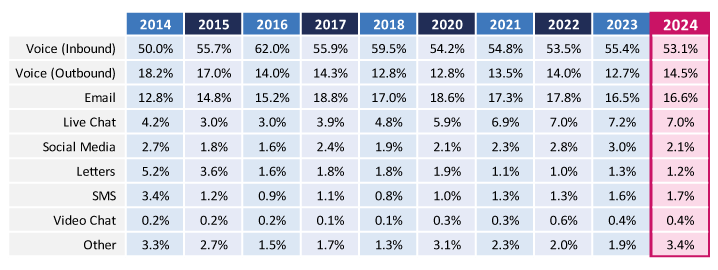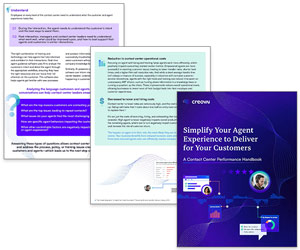Contact centres continue to offer diverse omnichannel options to their customers. Yet the use of video chats for customer experience is yet to dominate.
So, why are video chats still not being fully utilized as much as other channels in contact centres? Our Editor, Megan Jones, takes a look…
Video Chat Use Held Low and Steady – Even Throughout the Pandemic
Back in 2017, a global survey found that 87% of executives agreed that the use of video strengthens customer relationships.
However, our 2024 survey highlighted that this has not materialized into video being used as a core customer service offering. In fact, video is the least popular channel in customer service – even less popular than writing letters!
Even throughout the pandemic when many people were increasingly using video chat in their personal lives, and even for home-schooling, video chat use rates held low and steady at around 0.5%.

The Benefits of Video Include Side-By-Side Technical Support
Despite this trend, there are some key benefits to using video, including:
Customers Don’t Have to Rely on Descriptions – They Can See What the Agent Is Doing
Videos have an important place in contact centres as a means of technical support and demonstrations.
For example, if customers struggle to assemble or use a product or service, a video chat should allow them to see what to do as the agent explains each step.
Video Chats Can Boost First Contact Resolution Rates
As a knock-on effect, successful video calls can increase First Call Resolution rates.
This is because if a customer has a video call as a first contact with the brand and their concern or query is met with a satisfying resolution (or a demonstration that helps them), then they may not need to come back again for help.
In a Call Centre Helper article, Finlay Macmillen discussed video chats and told us:
“Visually demonstrating a problem makes it easier for an agent to provide tailored advice, with the same being true for co-browsing, which can help with navigating online resources and forms in real time with the customer. This enhanced collaboration helps reduce the need for multiple conversations, which can delay resolution.”
Agents Can Build Greater Rapport and Trust
Customers may also seek to use video chats to see who they’re talking to and ask multiple questions. This means of communication should enable their queries to be quickly resolved.
Not only is this positive for the customer, but when done well, it could also improve brand reputation, speed up queries and solutions, and improve customer satisfaction and the customer experience.
If a customer can see the customer services representative in person, the rapport and trust may be greater.
Video: The Rise of Video Chat?
Watch the video below to hear insights from when Call Centre Helper’s Xander Freeman spoke to Charles Kergaravat, CMO at Apizee, about the rise of video chat in customer service:
Use Cases of Video Chat in Action
So who is actually using video and harnessing these benefits?
Here are some real-life examples of use cases for video we’ve spotted in action:
Video Banking
Video banking is becoming more prevalent, due in part to the ongoing closures of physical branches for customers to visit, as according to Which,
“There were 410 closures in 2024: 90 from Barclays, 83 from Lloyds, 76 from Halifax, 68 from NatWest, 31 from Bank of Scotland, 28 from TSB, 20 RBS branches, 10 Ulster Bank branches and four Danske branches.
Already there are 116 closures pencilled in for 2025: 45 from Lloyds, 43 from Halifax, 14 from Bank of Scotland, eight from TSB and six from Barclays.”
The banks also largely claim that this approach increases availability and convenience for customers, and some of the banks offering this service include Barclays and Skipton Building Society.
Offering Sign Language Options for Customers Who Need It
Video appointments are also available in banks to better support customers who are deaf or hard of hearing, by making sign language specialists readily available – regardless of location – beyond what would be feasible to provide at short notice on a branch-by-branch basis.
As seen in this available service from Lloyds Bank.
Technical Support
Video chat is also a great way to offer technical support to customers, where it’s quicker and easier to show customers what to do side-by-side.
For example, Costa Coffee makes good use of video chat in their B2B contact centre to allow agents to offer coffee machine tech support to customers (for example, in a petrol station) – empowering them to fix issues remotely (and without sending an engineer to site!) – saving precious time for everyone involved.
There Are Disadvantages of Video Chat to Be Aware Of
Whilst there are several benefits to using video chat in the contact centre, there are some drawbacks to be aware of before rolling out this channel to your customers. These include:
Agents Can Feel Intimidated – Especially Handing a Complaint
If agents are new to video chats, they may worry about being seen by the customer. This could potentially feel intimidating, and if the customer has a complaint, they may prefer not to see the person they’re talking to.
Bandwidth
Traditionally, customer bandwidth has been considered a key barrier to the adoption of video chat in the contact centre, however the dial is starting to move on this, as Martin Hill-Wilson of Brainfood Consulting explains, “Bandwidth is starting to go as a barrier. For instance I now have 5G and an unlimited data plan, and many customers will have the same.”
Time-Consuming Calls
Even though video chats are highly personalized and allow for detailed discussions to resolve complex issues, they may be more time-consuming.
Perhaps for this reason, they are more appropriate for B2B or specialist customers (for example, based on loyalty or membership) rather than all customers.
For advice on reducing average handling time, read our article: 16 Ways to Reduce AHT – Without Damaging the Customer Experience
Agents Can Appear Unprofessional Having a Video Chat at Their Kitchen Table
With many agents now working from home, there’s also potential concerns around consistency of what their backdrop looks like – particularly if one agent is working from a home office and another at their kitchen table.
It’s far less consistent and can be seen as unprofessional when compared to being in a specially tailored video pod in a contact centre with a more uniform, on-brand backdrop.
Face-to-Face Video Calls Require Additional Body Language Training
There’s also the expense of additional training, as face-to-face video calls open additional risks.
It’s believed that approximately 55% of a message is transferred or communicated via body language. So, while this is easier to hide over the phone, there’s a big risk of getting it wrong for face-to-face video chats.
Therefore, for optimal success, contact centres need to train those conducting video calls on body language or visual communication. This can be costly and time-consuming and may prevent many contact centres from adopting this method of communication.
It Will Come Down to What’s Right for Your Customers
Overall, contact centre video chats can help organizations provide clear demonstrations, potentially increase call resolution rates and improve the quality of service.
However, rolling out video chat will depend on the type of business and the potential solution the contact centre is supporting.
For instance, a business that sells highly complex products is more likely to benefit from using video chat for technical support. Ultimately, it comes down to what’s right for your customers, as Martin Hill-Wilson of Brainfood Consulting concludes:

“In many ways, ‘video is the new voice’ – driven by a multimodal world that messaging (WhatsApp) has introduced into all our lives.
Yet it really comes into its own in scenarios where face-to-face communication is being removed but where trust still matters, and there’s value to be gained from taking a “show and tell” approach to help visualize servicing issues.
For example, in high-value sales and VIP service, as well as managing complaints, supporting online education, and enhanced tech support for broken mobiles and laptops.
Overall, customer cohorts have a pretty developed sense now on which situations are best served by which channel – so businesses should reflect on how that might be of use once they understand which channel customers pick and then align that with their own engagement use cases.”
Are You Offering Video Chat in Your Mix of Channels?
Join our LinkedIn community and let us know.
For more information on customer service solutions in the contact centre, read these articles next:
- Everything You Wanted to Know About Using Video in the Contact Centre…
- Can AI Really Handle Customer Complaints?
- Should Contact Centres Call Time on Meta’s Social Media Apps?
- Live Chat Quality – 7 Training Exercises to Improve It
Author: Megan Jones
Reviewed by: Jo Robinson
Published On: 11th Jun 2025 - Last modified: 1st Sep 2025
Read more about - Technology, Customer Experience (CX), Customer Service, Finlay Macmillen, Martin Hill-Wilson, Top Story, Video Solutions





















